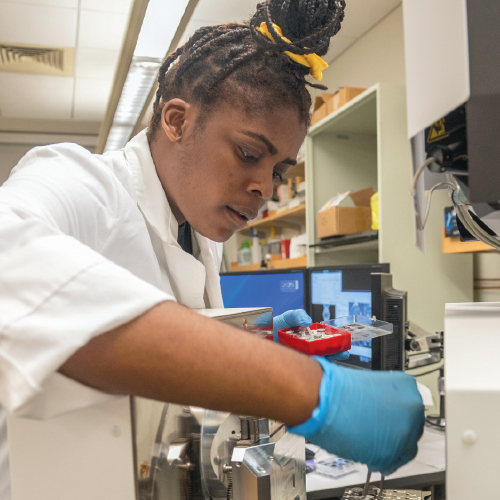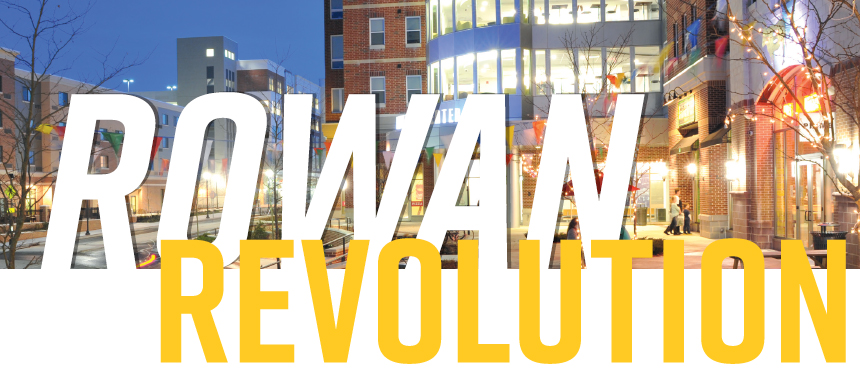Rowan revolution
Rowan revolution
How a decade of rethinking has reshaped the University’s future
By Kim Mulford ’94
Not so long ago, Rowan University was known as a well-regarded state institution graced with a record-breaking $100 million gift from Henry and Betty Rowan and a rising reputation for engineering education.
That was then.
Named the fourth fastest-growing public research university in the country by The Chronicle of Higher Education, Rowan is a vastly different place than it was scarcely a decade ago. Last spring, the nationally ranked university celebrated the largest Commencement in its 100-year history. In addition to roughly 4,500 bachelor’s candidates, the Class of 2023 included nearly 1,000 master’s and Ph.D. candidates—and more than 300 new physicians.
The story of how Rowan University became what some have called a “model for institutional transformation” is one of smart calculations, gutsy risk-taking and fresh thinking.
Unprecedented progress
Twenty years after the 1992 Rowan Gift, the University found itself at the center of a vigorous debate surrounding the future of New Jersey public higher education.
Reporters covered contentious hearings, passionate demonstrations, studies and proposals, as state legislators wrestled with calls to dismantle the University of Medicine & Dentistry of New Jersey (UMDNJ) and reorganize the state’s research institutions.
The state’s proposal to merge Rutgers–Camden with Rowan was met with some controversy. Though Rowan had only recently launched the state’s first new medical school in 35 years and its young engineering school was earning regional and national accolades, the University still had much to prove.
Amid heated debate, Rowan leadership patiently waited. Within months, the state shifted its approach, approving the New Jersey Medical and Health Sciences Education Restructuring Act, dismantling UMDNJ and dividing its academic and clinical divisions between Rutgers University and Rowan.
In 2013, state legislation established Rowan as New Jersey’s second comprehensive state research institution and Rowan officially welcomed the School of Osteopathic Medicine in Stratford. With that, Rowan became the nation’s second university to offer both the MD and DO degree programs.
The legislative moves propelled Rowan into an era of rapid expansion and transformation, one that required deft leadership to manage. In 2013, just a year into his administration, President Ali Houshmand set lofty goals for enrollment, research and funding, positioning the institution to become one of the region’s most critical economic engines.
The future, Houshmand said at the time, was “limitless.”
Strategic, explosive growth
Poised for expansion, the University’s mission shifted from a primarily educational pursuit to one advancing research, particularly in science, technology, medicine and, of course, engineering.
To enact its new mission, Rowan adopted four student-centered, strategic pillars—increasing affordability, expanding access, boosting quality and driving the region’s economy forward. With Houshmand at its helm, Rowan quickly saw a radical change in its institutional culture and encouraged an entrepreneurial outlook, one that today remains transparent, fiscally responsible and value-conscious.
Increasing affordability
Acutely aware of student debt and the rising cost of a college education, Houshmand developed an innovative solution: stronger partnerships between the University and nearby community colleges.
In 2014, Gloucester County College became the first partner, adopting the Rowan name while remaining independent. Burlington County College followed, renaming itself Rowan College at Burlington County in 2015. With Cumberland County College’s 2019 merger with its Gloucester County peer, the two became Rowan College of South Jersey.
Rowan’s community college partnership model took off as the first of its kind with an aligned curriculum and 3+1 academic programs keeping the cost of a bachelor’s degree to about $30,000. Today, 30 degree tracks serve students in 3+1 programs.
Because of this compelling success story for so many students, the New Jersey College Affordability Study Commission highlighted Rowan’s innovative 3+1 programming in its 2016 report to the New Jersey Legislature. In 2018, Gov. Phil Murphy approved legislation to standardize the model statewide, a move endorsed by the New Jersey Business and Industry Association.
And while others have since adopted the 3+1 model, no other universities in New Jersey share their identity with a community college, making Rowan’s relational approach unique. The Rowan name conveys a sense of value and prestige now accessible to far more students striving to achieve.
To further boost affordability, Rowan invested more in its students, boosting scholarships and tuition waivers from $12 million annually to $43 million within a decade. Today, Rowan students from families with an adjusted gross income below $65,000 may attend for free.
And, after suffering for decades from an inequitable state funding formula, Rowan successfully lobbied Trenton to increase the Tuition Aid Grants given to its New Jersey students to equal those given to their peers attending other state research institutions—a win for students in financial need across New Jersey.
Expanding access, encouraging inclusion
Even as Rowan addressed financial barriers to higher education, it uncovered invisible institutional barriers. One by one, the institution began the hard work of eliminating roadblocks to enrollment and degree completion.
In 2017, Rowan established Flying First to provide tools and opportunities to help attract, support and ensure access for first-generation students. The initiative complemented the Rowan Success Network, a program to help all students achieve their goals, improve retention and increase graduation rates.
Two years later, Rowan became the first university in New Jersey and one of a few in the nation to establish an entire division working to build a safe and welcoming environment for historically marginalized populations. The Division of Diversity, Equity & Inclusion was created to promote and support inclusion and belonging regardless of race, gender, sexuality, age, faith, national origin, political perspective or ability.
To fulfill its mission, the division brought together existing offices and departments that addressed compliance and accountability, student support and services, student programming, and faculty professional development.
The division found new avenues to support Rowan’s strategic goals. In 2020, the Center for Access, Persistence & Achievement began serving students from recruitment through graduation, helping students from disadvantaged backgrounds to succeed in postsecondary and professional academic programs.
Far from being an ivory tower experiment, the institution’s commitment to community asks everyone to value and respect their neighbors in practical ways. It also provides resources, guidance and encouragement that serve Rowan’s students and employees on all campuses, furthering its public mission.
Celebrating neurodiversity
In 2021, Rowan University established another first in New Jersey, its Center for Neurodiversity, operated by the Division of Diversity, Equity & Inclusion and the Division of Academic Affairs. The expansion of services stemmed directly from Houshmand’s commitment to access and inclusion and from the generosity of parents who saw firsthand the value of Rowan’s commitment to neurodiverse students. With a major gift given as seed funding to create and sustain the university-wide Autism PATH Program, Sunitha Menon-Rudolph and Paul Grand helped secure support and opportunity for students in one of Rowan’s signature initiatives.
“This is about human beings trying to be supportive of other human beings,” Houshmand said. “For me, the issue is not just working with neurodiverse students while they are students, because that we can do. For me, the bigger issue is what happens afterwards, whenthey graduate. I want to make sure they can function, run a business, create wealth and have a happy life.”
Innovating health sciences and medical education
Already among four universities in the nation granting both the MD and DO degrees, Rowan began 2022 by announcing an innovation unlike any other. Through its landmark partnership with Virtua Health, South Jersey’s largest health system, Rowan created Virtua Health College of Medicine & Life Sciences of Rowan University. Supporting the new college with an $85 million investment, Virtua Health demonstrated its commitment to the academic health partnership.
Now developing a veterinary school, Rowan is poised to become one of only two institutions in the nation with three medical schools. The distinction demonstrates how Rowan meets critical needs with a deep sense of public service and an agile, entrepreneurial mindset. (See more on page 18.)
Rising ambitions, quality
Between 2010 and 2022, applications more than tripled. The only period of comparable institutional growth came mid-century, during President Thomas E. Robinson’s leadership. Then, as in the past decade, transformation came through responding to demand for higher education opportunities, hiring faculty and professionals to expand academic programs, services and outreach, developing partnerships and purchasing land to expand capacity.
Even as it developed new graduate programs, the University has remained centered on serving its undergraduate students in every college and school. Building on decades of valuable field experiences and the Henry M. Rowan College of Engineering’s foundational “hands-on, minds-on” approach to education, the University’s approach has included opportunities for undergraduate students to share in research.
To accommodate its fast-growing student body, Rowan built capacity in labs, classrooms and field experience, increasing undergraduate and graduate school faculty by more than 54 percent, hiring tenured, tenure-track and three-quarter-time faculty and lecturers and engaging 1,750 clinical and volunteer faculty at its two medical schools.
Along the way, Rowan has worked to recruit masterful and rising researchers. Today, Rowan faculty include 14 recipients of the National Science Foundation’s CAREER Award, one of the federal agency’s most prestigious honors for early career faculty.
The push for excellence has given ambitious students opportunities to earn prestigious awards, raising the institution’s reputation. Since 2000, the student body has included 25 Fulbright recipients, eight Goldwater and seven Boren scholars.
With the distinction and breadth of two medical schools, study and discovery in health sciences has continued to expand, adding to research in dozens of other discipline areas. Since 2013, the University has attracted more than $433 million in research awards and contracts for projects ranging from health care and biotech to materials and transportation.
The list of research funders has been prestigious from the start, with early-stage, modest awards to large, multiphase funding for major projects. Rowan researchers have won grants and become project partners on work with NASA, National Science Foundation, Army, Navy, state and federal transportation departments, among others.
By 2018, Rowan received classification as a Carnegie R2 doctoral university with high research activity, a distinction shared with just 133 of more than 4,300 higher education institutions. That year, for the first time, Rowan entered the U.S. News & World Report national universities ranking and has been recognized ever since as a top 100 public university.
Rowan venture funding
Near the start of Rowan’s focus on applied research, the Rowan University Foundation began investing in faculty and student endeavors targeted at problem-solving, innovation and entrepreneurship. Begun in 2014 with $5 million, the $25 million Rowan Innovation Venture Fund provides early-stage funding to students, faculty and local entrepreneurs whose projects and products are ready to compete in the marketplace.
The fund has provided more than $2.4 million to life sciences companies, more than $1.2 million to software/mobile app firms, some $450,000 to telecommunications startups and $150,000 to entrepreneurs in the food and beverage sector.
Exponential potential
Under Houshmand’s leadership, Rowan has made it a strategic priority to ensure that more of New Jersey’s students pursue their future in the state, contributing as citizens and professionals to the region’s development and quality of life.
Public-private partnerships have made academic innovation possible. So, too, has support from generous, visionary donors, granting more opportunities for Rowan students. Since 2012, donors have invested $264 million in new gifts and pledges, providing endowments, scholarships, program and facilities support, among many designated gifts.
Rowan’s growth in health care education, clinical care and research has exponential potential and its tradition of transformation continues, Houshmand said.
“All around us, I see opportunities,” Houshmand said. “Rowan University’s future is bright because we recognize the challenges ahead.”

